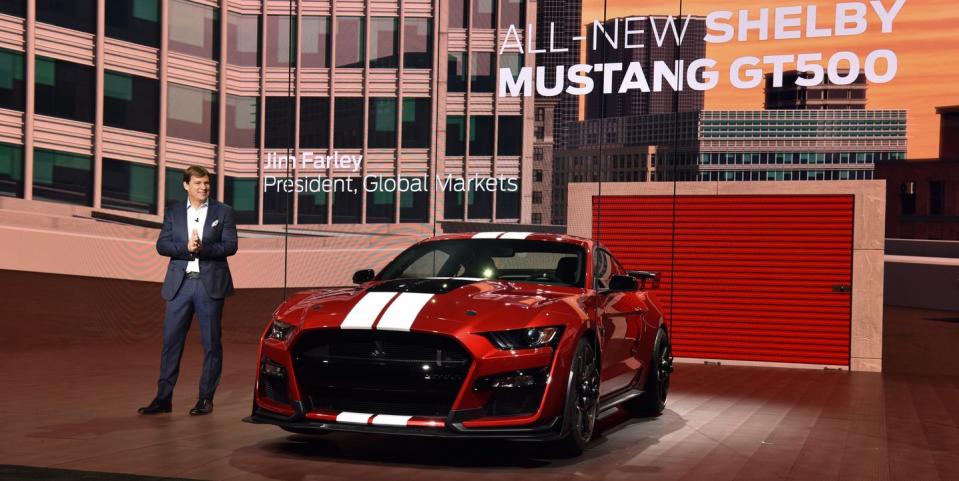Gen-VII Ford Mustang Confirmed for Unveiling This Fall

CEO Jim Farley (pictured above at 2019 NAIAS for Shelby GT500 unveiling) also described a future for the Blue Oval that will transition to EVs without designing a one-battery-platform-fits-all cost-management strategy.
Ford also plans a major overhaul of its retail philosophy without upending its traditional dealership relationships.
While GM plans to sell 1 million EVs globally by 2025, Ford says Model E expects to sell 2 million by 2026.
Ford has confirmed it will unveil an all-new seventh-generation Mustang—the gas-powered one—at the North American International Auto Show this September in Detroit.
“It is stunning, and I am excited to share it,” said CEO Jim Farley in Ford Motor Company’s second-quarter earnings report Wednesday evening. Farley shared no further details on the Mustang, including whether there will be a battery-electric version to compete with Chevrolet’s announced e-Ray Corvette. But he did say a new F-Series Super Duty pickup truck also will debut at the downtown Detroit show, which begins with a media day on Sept. 14. Public days are Sept. 17-25.
Like its legacy competitors, Ford is on its way to an electric-vehicle future, and without naming names, Farley described a future for the Blue Oval that will handle the transition to EVs without designing a one-battery-platform-fits-all cost-management strategy. Future EVs will answer the question, he said, of “who is and will be in the best position to design truly distinct products” that people love.
Conversely, “the days are kind of over where you have to build a new upper body,” Farley said. You can use the same body engineering and update the products for customers not by redesigning fenders or taillamps, but with constant software updates, new digital display technology or driver-assistance technology and more powerful motors, he said.
Farley seems to be espousing the design philosophy of Tesla, which has modeled the 3, X, and Y after the Model S, which hasn’t changed its look since its 2013 model year debut. His comments also represent a counterpoint to General Motors’ EV strategy, which is built around a single, flexible, modular Ultium battery platform that underpins all of the automaker’s coming EVs, from midsize crossovers and luxury cars to full-size pickups and even the GMC Hummer off-road beast.
Ford also plans a major overhaul of its retail philosophy without upending its traditional dealership relationships. For the consumer, this means a much larger share of pre-ordered cars and trucks rather than buying out of existing inventory. The big question is whether consumers will adapt to this new European-style model, which comes in response to vehicle production hindered over the past two years by a global pandemic and shortages for components, especially computer chips.

Farley and CFO John Lawler also shed more light on Ford’s reorganized automotive “divisions,” which will begin reporting financials separately, rather than as one unit, beginning in 2023. The three are…
•Ford Blue: “Iconic” internal-combustion-powered cars and trucks. Bloomberg has reported Ford intends to eliminate 8000 salaried jobs from this division.
•Ford Model E: Electric vehicles, led by the Mustang Mach-E and F-150 Lightning. Ford expects to sell 14,000 EVs (globally) this month on its way to 600,000 per year by the end of 2023. While GM plans to sell 1 million EVs globally by 2025, Ford says Model E expects to sell 2 million by 2026.
•Ford Pro: Commercial trucks and vans, including EVs. Traditionally, this is perhaps Ford’s greatest strength. Ford has sold or leased more than 3,000 all-electric e-Transits in the first half of the year, holding 95% EV van market share, Farley said.
While Ford continued to suffer supply issues and production constraints, just like everyone else in the business, it reported adjusted earnings before income taxes of $3.7 billion from $40.2 billion in gross revenues, up $2.7 billion and $13.4 billion, respectively, over the first half of 2021.

 Yahoo Autos
Yahoo Autos 